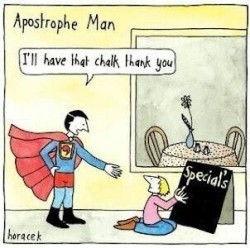Apostrophes: When To Use Them – And When Not To

Some apostrophes are not OK!
Apostrophes—those things that look like single quotes, or maybe commas hanging in the air—have a couple of uses in the English language. First, they are used for contractions. Second, they are used to indicate possession. We are going to talk all about possessives in next week’s blog post (can you wait?). That leaves us with contractions.
Contractions are word combinations with letters left out to save space, I guess. Or perhaps to make it easy to say in conversation. They slide off the tongue much more easily than two separate words. The apostrophe is put in place of the missing letter (or letters). The common words to be shortened in a contraction are not, have, and are (am, is)
Some contractions with not: didn’t, isn’t, aren’t, haven’t, wouldn’t, won’t, can’t.
Some contractions with have: could’ve, would’ve, I’ve, you’ve, we’ve
Some contractions with the to be verb (are, am, is): I’m, you’re, we’re, he’s, it’s, they’re
Well, you know I’m not writing this blog post to talk about contractions. You know all about them. Almost. So here is all I am going to say about contractions, before I move on to when NOT to use apostrophes:
1. In formal writing (as opposed to conversation or a friendly e-mail), I would suggest avoiding some contractions. The contractions with n’t for not are fine, but I would spell out words such as could have, would have, should have, I have, you have, we are, most of the time. In particular I would not use contractions where the shortened word is have. Is it wrong? No. But it does sound more conversational and less professional.
2. Oh, please, remember that the contraction meaning it is is the one with the apostrophe (it’s).
3. Oh, please remember to put the apostrophe in the you’re that means you are (not your)!
Possessives is the topic for next week, so now we have come to the when not to use an apostrophe part.
Turn your attention to the apostrophe man cartoon above. Yup, you have seen the apostrophe used this way. You have seen it on signs, you have seen it in menus, and you have seen it on Facebook. DO NOT USE an apostrophe for plurals. Plural words, unless they are plural possessives, do not have apostrophes! EVER, almost. That means no apostrophes in plural words, numbers, letters, or symbols.
The only time you need an apostrophe in a plural is when the word, number, letter or symbol would be confused with another word if there were no apostrophe. Let’s see…how many things does that include?
If you are talking about the letter A, use an apostrophe to make it plural. Otherwise, it will look like as.
I got all A’s on my report card.
If you are talking about the letter I, use an apostrophe to make it plural. Otherwise, it will look like is.
Make sure you capitalize all your pronoun I‘s.
If you are talking about the letter U, use an apostrophe to make it plural. Otherwise, it will look like us.
There are two u‘s in the word uncut.
It doesn’t matter whether you use the letter in uppercase or lowercase.
Also, note that when you use a letter, number, word, or symbol as itself, it is italicized. However, the apostrophe/s is not in italics. This goes for words, numbers, letters, and symbols without apostrophes as well. The s is not italicized.
There are too many ands in your sentence. (The s at the end of and is not in italics.)
Yes, this rule applies to numbers too.
Do you remember the 1960s? (not 1960′s)
Do you remember the ’60s? (Here, the apostrophe is standing in for the 19, making it a contraction of sorts. But there is no apostrophe after 60.
The letters a, i, and u need apostrophes in their plurals to avoid confusion. That is just about it.
Next week, apostrophes return as we talk about possessives.



